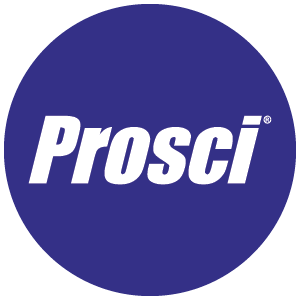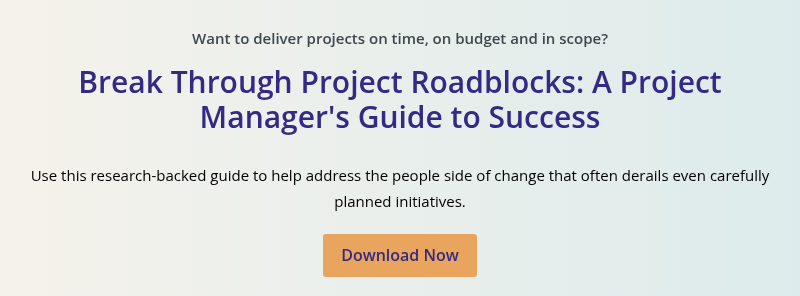Integrating IT Project Management and Change Strategy

7 Mins
Published: May 23, 2025

Change is inevitable, but success isn't guaranteed, even with technical expertise. If you want a truly successful IT transformation, you need to apply change management best practices from the outset.
At Prosci, we've spent decades proving that projects succeed when they put people first. With our Unified Value Proposition, we unite technical excellence with a laser-focused, people-driven approach, creating solutions that deliver lasting impact.
Discover how bringing together IT project management and change management can position your organization to thrive even during the most challenging times. Using the right approach can help you redefine change in your organization—and achieve goals not thought possible.
What Is IT Project Management?
IT project management turns ideas into real solutions. IT Project Management refers to the discipline of planning, executing, and overseeing information technology projects. It involves applying specific knowledge, skills, tools, and techniques to meet project requirements and achieve desired outcomes. It sets a clear direction, aligns teams, and manages scope, time, and risk to deliver complex IT initiatives—from software development to hardware upgrades—with precision and purpose.
IT project managers often use known methods to break down complex tasks into clear steps. Whether it’s Agile methods like Scrum, traditional Waterfall methods, or process-driven approaches like Lean or Six Sigma, these methods help teams stay focused and work effectively. These project management approaches also align well with the Prosci Methodology, making sure people are ready to adopt and sustain changes.
With strong planning and a flexible mindset, IT project management drives transformation. It solves problems, accelerates progress, and helps organizations grow in a rapidly evolving digital world.
Common Challenges in IT Project Management
Even well-planned projects can hit obstacles. But the most successful teams plan for them early. Here are three of the most common challenges that can derail IT initiatives if left unchecked:
Scope creep
When new tasks and features are added without adjusting the plan, teams get stretched thin and budgets run dry. What starts as a focused project can quickly become unmanageable. Clear boundaries and disciplined change control keep the work on track.
Communication breakdown
Misalignment between teams and decision-makers leads to missed requirements, errors, and costly delays. The risk is even higher for leaders, who are 56% more likely to experience extensive disruptive change than individual contributors. Consistent communication and targeted support help leaders stay engaged and teams stay focused.
Resistance to new technologies
People naturally hesitate when asked to change how they work. Without support, uncertainty can turn into pushback. Addressing concerns early and building readiness through change management reduces friction and builds momentum.
The solution is to plan ahead. When you apply proactive change management, set clear expectations, and focus on the outcomes that matter, you reduce risk and keep the project moving forward.
Role and Essential Skills of an IT Project Manager
An IT project manager wears many hats. They oversee everything from timelines and budgets to communication and risk analysis. Their job is to plan the work in detail, then rally the project team, clear obstacles, and keep the project moving forward smoothly.
These duties can evolve over the course of a project, from its start to its design and implementation stages.
To succeed, an IT project manager needs certain skills:
- Technical know-how to understand the Software Development Lifecycle (SDLC), whether it's software development, hardware installation, or system integration.
- Clear communication to ensure everyone—whether a team member, a business sponsor, or senior management—knows their role and stays aligned.
- Leadership skills to make decisive choices, solve problems quickly, and keep the team’s morale high through challenges.
- Time and resource management to break down big tasks into manageable steps, set realistic project schedules, and adapt to changing circumstances.
To effectively manage projects, IT project managers must also engage with executive sponsors who play a crucial role in supporting the initiative. The Sponsor Activity Model outlines the essential activities and responsibilities of sponsors throughout the project lifecycle, ensuring alignment and support at every stage.
Sponsor Activity Model

With these skill sets, an IT project manager can meet technical goals and build a strong foundation for long-term success, guiding projects to smooth completion and real growth.
Key Phases of IT Project Management
With a strong foundation in place, it's time to move into the key phases of IT project management—the core lifecycle that takes your project from concept to completion. Each phase keeps your team aligned, your progress on track, and your strategy ready for change.
Initiation
This first phase sets the stage:
- Define your project’s purpose and project scope
- Identify key stakeholders and conduct a feasibility study
- Establish a strong starting point so everyone is aligned with the project charter
Planning
A detailed plan is your project’s backbone. In this phase, you:
- Break down the project into smaller, manageable tasks
- Set clear project timelines, budgets and resource allocations
- Pinpoint potential risks and outline strategies using risk registers
- Communicate responsibilities clearly to the entire team
Execution
Now it’s time to turn plans into action. During execution you:
- Have your team work on dependent tasks as assigned
- Ensure open lines of communication so everyone stays informed
- Focus on delivering tangible project deliverables, whether it’s launching new software or upgrading infrastructure
Monitoring and controlling
This phase runs alongside execution to keep you on target:
- Continuously track progress and measure performance against your project plan template
- Address issues or deviations as soon as they arise
- Make real-time adjustments to stay aligned with your project outcomes
Closing
The final phase brings everything together. Here you:
- Wrap up all tasks and finalize the project deliverables
- Review successes, challenges and key lessons learned
- Document insights to strengthen future real-world projects
Working through each phase—from initiation to close—keeps your project focused and moving with purpose. These stages build on each other. They turn strategy into action through clear planning, strong communication, and a commitment to continuous improvement at every step.
Why IT Project Management Needs Change Management
When you combine solid IT project management with proactive change management, you set the stage for exceptional results. In fact, excellent change management is linked to project success rates that are seven times higher.
Correlation Between Change Management and Project Success
Why change management matters
Change management is what turns technical upgrades into lasting results. When you lead IT projects with both systems and people in mind, you reduce friction, build momentum, and deliver impact that lasts.
- Smooth transitions – Change management prepares your team for what’s coming, preventing resistance and easing the shift to new systems or processes.
- Stronger adoption – When people feel supported, they’re more likely to embrace new tools and ways of working, accelerating project success.
- Reduced risk – Effective change management identifies obstacles early, helping you tackle issues before they derail your project.
The payoff is real. Sixty-three percent of organizations report measurable performance improvements from digital transformation efforts, with many seeing gains of over 10%. Those results don’t happen by chance—they come from leading with purpose, clarity, and a plan that supports both people and technology.
Every IT project involves two types of change: technical and human. Integrating change management from the start ensures they move together. It keeps communication clear, expectations aligned, and your team equipped to handle what’s next. The result is a more agile, capable organization ready to lead.
The Unified Value Proposition: IT Project Management and Change Management Together
Bringing IT project management and change management together creates a unified strategy that delivers real results. You meet project goals while equipping your people to adopt new technology and ways of working with confidence. When technical execution and people readiness move in lockstep, change takes hold—and value scales faster.
What can you expect when these disciplines work together?
- Shared vision – Combining technical planning with change management keeps everyone aligned. It creates a clear picture of the future, ensuring that both technical deliverables and people-driven change efforts move in sync.
- Better communication – Integrating both methodologies promotes continuous dialogue. This means issues are addressed quickly, questions are answered promptly, and gaps in understanding are minimized.
- Increased adoption – With change management guiding the way, employees are more likely to adopt new systems enthusiastically, resulting in smoother rollouts and long-term success.
- Risk reduction – When potential obstacles are identified early through change management practices, you can take proactive steps to keep your project on track.
- Improved efficiency – A well-coordinated team working under a unified framework saves time and resources. This speeds up project execution and enhances overall performance.
- Empowered teams – Focusing on the people side of change builds confidence within the team. This empowerment translates into higher morale, better collaboration, and a stronger commitment to achieving project goals.
We describe this combination of benefits as the Unified Value Proposition, where project execution and people readiness come together to accelerate success. When you lead both the technical and human sides of change with equal focus, transitions become smoother, adoption rises, and impact grows.
Prosci Unified Value Proposition

Ultimately, the unified value proposition blends the best of both worlds. IT project management provides the structure, timelines and resources, while change management ensures your team is engaged, prepared and excited about the transformation. Together, they create a strategy that not only tackles technical challenges but also nurtures an environment where innovation and continuous improvement can thrive.
Real-World Benefits of Integrating Change Management
When organizations combine IT project management with change management, the results speak for themselves. This integration improves internal processes and leads to real, measurable business outcomes.
Improved adoption and engagement
One of the most powerful benefits of integrating change management into IT project management is increased adoption—how readily people embrace and engage with the change.
Change management prepares, equips and supports people through change. When employees understand the “why” behind a new system and feel confident in their ability to adapt, they’re more likely to participate fully. In the context of IT initiatives, this translates to faster implementation timelines and sustained, effective use of new tools and technologies.
Project success and ROI
There’s also a clear link between integration and higher rates of project success and ROI. According to Prosci research, 81% of organizations that planned for reinforcement and sustainment activities met or exceeded their project objectives. These activities—central to the Prosci Methodology—help teams stay focused, reinforce new behaviors, and lock in change long after go-live.
Impact of Planning For Reinforcement on Project Success

Preventing resistance
Another major benefit of this integration is a lower rate of change resistance and improved morale. Change can be stressful, especially in fast-paced IT environments. But when you keep your team informed, involved and supported, they’re more likely to embrace change with readiness, rather than resistance. This creates a more positive experience for everyone, leading to stronger collaboration and smoother day-to-day operations.
In short, integrating change management into project management creates a stronger foundation for success. It improves how people work together, increases the value of your technology investments, and ensures that every project not only meets expectations, but sets the stage for lasting growth. If you want your IT projects to succeed in the real world, change management isn’t optional.
Getting Started With IT Project and Change Management
Are your people as prepared as your systems? It’s not a trivial question. If you want to take your IT projects to the next level, you need to make sure the answer is a resounding “yes”. And the way to prepare them is to integrate change management into your project from day one.
Prosci resources help you build a project plan that supports both the technical and human sides of change. When you align people and technology under one clear strategy, you create momentum, drive adoption, and build a future-ready organization that can thrive through change. Now is the time to start.





